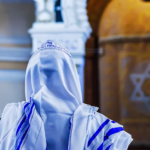I’ve often scratched my head wondering exactly which tallits should be categorized as traditional, and which should not. In practice, all of our black-striped, white-on-white, blue-striped, nonslip, chassid and Yemenite tallits are categorized under a parent category called “Classic Tallit.”
So what does that leave? The only other tallit categories we list are “Modern” and “Hand-Woven.” Although one or two of our hand-woven tallits have conservative black- or blue-striping patterns that look akin to our tallits manufactured by Mishkan Hatchelet or Talitania, the uniqueness of the weave and the fringes really sets them apart still.
Then we have a half-dozen manufactured tallits which we categorize as modern, e.g. the Sapir, which does not have a white base color, but a soft blue, or the Nitai, which has gray and burgundy striping.
Oh, and I almost forgot, there’s another category called “Rainbow Tallit” which includes the inimical Bnei Ohr.

How do you go about choosing a traditional black-striped tallit when they all look fairly similar on a screen? Some people are particular about the striping pattern, others are concerned primarily with the fabric and a handful of prospective tallit buyers are looking at other features, such as the fringes, corners squares and atara (neck band). If you scroll down to the bottom of just about any category on our website you’ll find a comparison of the various talllits shown above.
Within the rubric of traditional tallits, some are a bit more toward the modern end of the spectrum. If you want a strictly traditional look, you’ll probably want a tallit with a plainer atara (neck band). Sometimes we get customers who insist on having the Tzitzit Blessing embroidered on the atara (some even think it’s mandatory!), but in fact this is a feature that has come into vogue fairly recently. I doubt you’ll find that on your grandfather’s tallit. As a rule, the tallit manufacturers will put an atara with the bracha on tallits they deem slightly less traditional, namely those with more color. So a tallit that has only black, white or blue striping will have a plain atara, while any of the following tallits have an atara with the blessing:
- Blue-silver
- Blue-gold
- Black-silver
- Black-gold
- White-silver
- White-gold tallit
And it goes without saying that the more colorful tallits also include the Tzitzit Blessing.

